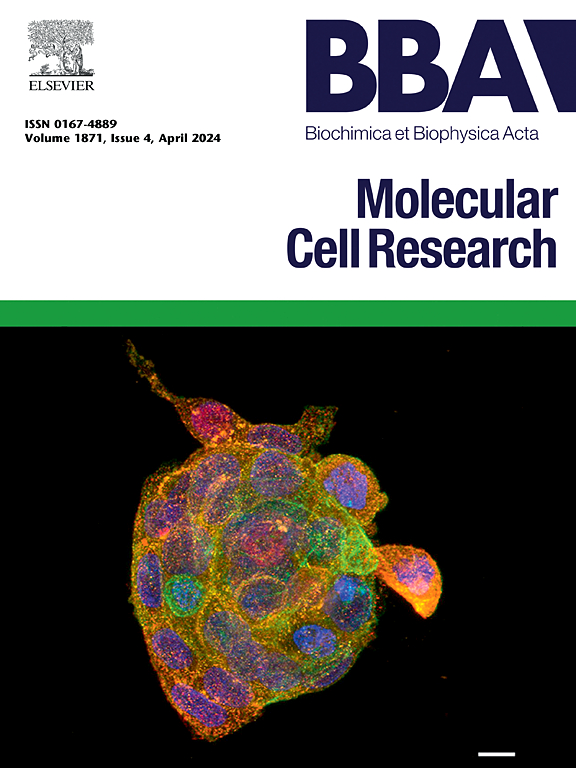Inhibition of NAMPT as a therapeutic strategy to suppress tumor growth in lymphangioleiomyomatosis
IF 3.7
2区 生物学
Q1 BIOCHEMISTRY & MOLECULAR BIOLOGY
Biochimica et biophysica acta. Molecular cell research
Pub Date : 2025-05-08
DOI:10.1016/j.bbamcr.2025.119986
引用次数: 0
Abstract
Lymphangioleiomyomatosis (LAM) is a rare, progressive lung disease driven by mutations in the TSC1 or TSC2 genes, leading to constitutive mTORC1 activation and uncontrolled cell proliferation. Current therapies, like rapamycin effectively stabilize disease progression but mainly exert cytostatic effects and promote autophagy, a survival mechanism in LAM cells. These limitations highlight the need for the development of innovative therapies to achieve more effective and lasting results. To explore alternative therapeutic targets, we investigated the role of nicotinamide phosphoribosyltransferase (NAMPT), a key regulator of NAD+ biosynthesis, in LAM and TSC2-deficient cells using a potent inhibitor, FK866. Our study demonstrates that FK866 depletes NAD+ levels in these cells, exerting a dual effect by activating AMPK and subsequently inhibiting mTORC1 signaling while suppressing autophagy. Unlike rapamycin, FK866 does not induce compensatory Akt activation, significantly inhibits LAM cell proliferation and induces apoptosis. Additionally, using an in vivo chicken egg chorioallantoic membrane (CAM) model, we showed that FK866 treatment significantly reduces LAM tumor growth compared to controls suggesting that NAMPT inhibition disrupts metabolic and survival pathways critical for TSC2-deficient cell viability and tumor progression. Our results establish NAMPT as a promising therapeutic target for LAM, offering a two-prong strategy to suppress tumor growth and enhance apoptosis, providing an alternative to current mTOR-based therapies.
抑制NAMPT作为抑制淋巴管平滑肌瘤病肿瘤生长的治疗策略。
淋巴管平滑肌瘤病(LAM)是一种罕见的进行性肺部疾病,由TSC1或TSC2基因突变驱动,导致组成性mTORC1激活和不受控制的细胞增殖。目前的治疗方法,如雷帕霉素,有效地稳定了疾病的进展,但主要是发挥细胞抑制作用和促进自噬,这是LAM细胞的一种生存机制。这些限制突出了开发创新疗法以获得更有效和持久效果的必要性。为了探索其他治疗靶点,我们使用一种有效的抑制剂FK866研究了烟酰胺磷酸核糖基转移酶(NAMPT)在LAM和tsc2缺陷细胞中的作用,NAMPT是NAD+生物合成的关键调节因子。我们的研究表明,FK866在这些细胞中消耗NAD+水平,通过激活AMPK,随后抑制mTORC1信号传导,同时抑制自噬,发挥双重作用。与雷帕霉素不同,FK866不诱导代偿性Akt激活,显著抑制LAM细胞增殖并诱导凋亡。此外,通过在体内的鸡蛋绒毛尿囊膜(CAM)模型,我们发现与对照组相比,FK866治疗显著降低了LAM肿瘤的生长,这表明NAMPT抑制破坏了对tsc2缺陷细胞活力和肿瘤进展至关重要的代谢和生存途径。我们的研究结果表明,NAMPT是一种很有希望的LAM治疗靶点,它提供了抑制肿瘤生长和增强细胞凋亡的双管齐下的策略,为目前基于mtor的治疗提供了一种替代方案。
本文章由计算机程序翻译,如有差异,请以英文原文为准。
求助全文
约1分钟内获得全文
求助全文
来源期刊
CiteScore
10.00
自引率
2.00%
发文量
151
审稿时长
44 days
期刊介绍:
BBA Molecular Cell Research focuses on understanding the mechanisms of cellular processes at the molecular level. These include aspects of cellular signaling, signal transduction, cell cycle, apoptosis, intracellular trafficking, secretory and endocytic pathways, biogenesis of cell organelles, cytoskeletal structures, cellular interactions, cell/tissue differentiation and cellular enzymology. Also included are studies at the interface between Cell Biology and Biophysics which apply for example novel imaging methods for characterizing cellular processes.

 求助内容:
求助内容: 应助结果提醒方式:
应助结果提醒方式:


